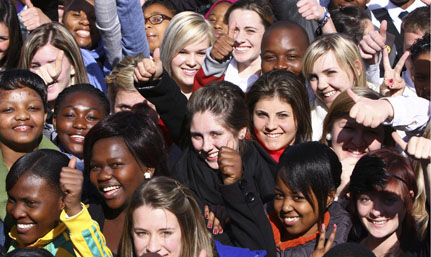|

|
| Photo: Hannes Pieterse |
The long application process, panel interviews and nail-biting wait finally came to an end the past week, when the cream of our first-year class of 2011 gathered in the Scaena Theatre on our Bloemfontein Campus, for their first group meeting as the selected Leadership for Change cohort.
These 150 students, from all our faculties, will over the following year be groomed to be leaders, not only at the university, but also in their respective fields and chosen careers.
The first group of students will depart for their respective universities in America and Europe on 22 September 2011, where they will spend two weeks. The second group of students will depart for universities in Japan in January 2012.
Although they have all passed a gruelling selection process, the real hard work is only starting now for these bright young students.
The programme will take place in four phases. During the preparation phase, which has now kicked off, students are prepared for the experience ahead, while being made aware of exactly what to expect from the programme.
In the study-abroad phase, students will be placed at 15 partner institutions in various countries, and will be divided into groups of six to twelve people. According to Prof. Aldo Stroebel, Director of International Academic Programmes, the groups will be diverse, in that there will be a mix of races, genders and study fields, which should guarantee dynamic interaction.
During the group’s first meeting this week, they were informed of the important goals of the Leadership for Change Programme, by Mr Rudi Buys, Dean of Student Affairs.
He imparted the gravity of their selection on the students by saying, “You may not get it yet, but I understand the reason we are all here. I understand that by looking at what you achieve after this programme, we can tell what the country could possibly achieve in the future. It is immensely moving to see the way you all carry yourselves, since I can see something special and unique in each of you.”
“You are all here, not because of which school you went to, or your race, or who your parents are, but because you all show potential to be something great.”
Prof. Stroebel reminded the group that despite the excitement that they all have about visiting universities in America, Europe and Asia, these visits should be seen as study trips.
“You may have three days to acquaint yourselves with the surroundings, but after that there will be very little sightseeing and a lot of hard work.”
They will participate in programmes designed by their respective host institutions, aimed at exposing them to different cultures, lifestyles and beliefs.
They will be accompanied by our staff, who Prof. Stroebel says will grow with the students, as they will be expected to guide the students through their tasks and assignments and interact with them on a daily basis.
Upon their return, there will be a debriefing phase, during which they will be expected to provide feedback on their experiences, as well as submit assignments which they will be assigned at their respective institutions.
The final phase is known as the impact phase, as this will see the students apply what they have learned in a positive manner and help drive the university to the future and to becoming a world-leading tertiary institution.
Media Release
1 August 2011
Issued by: Lacea Loader
Director: Strategic Communication
Tel: 051 401 2584
Cell: 083 645 2454
E-mail: news@ufs.ac.za